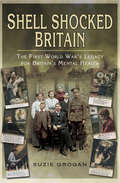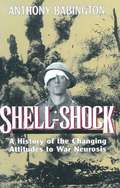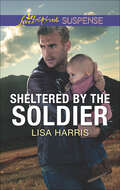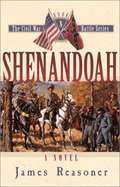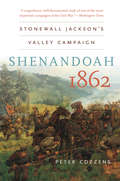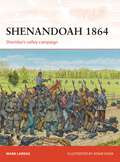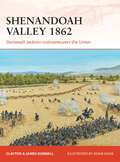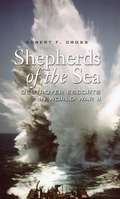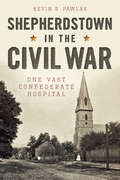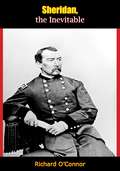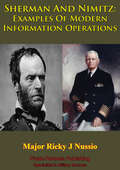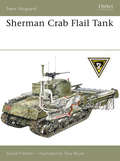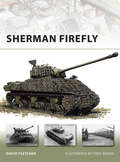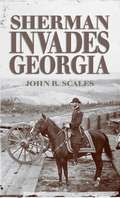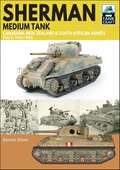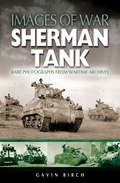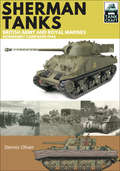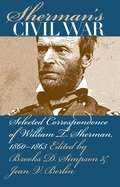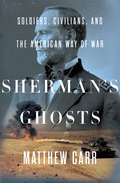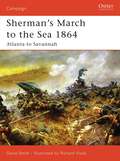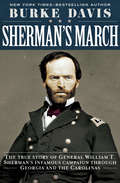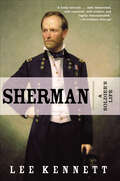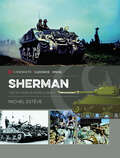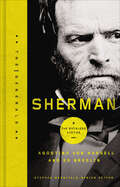- Table View
- List View
Shell Shocked Britain: The First World War's Legacy for Britain's Mental Health
by Suzie GroganWe know that millions of soldiers were scarred by their experiences in the First World War trenches, but what happened after they returned home? Suzie Grogan reveals the First World War's disturbing legacy for soldiers and their families. How did a nation of broken men, and 'spare' women cope? In 1922 the British Parliament published a report into the situation of thousands of 'service patients', or mentally ill ex-soldiers still in hospital. What happened to these men? Were they cured? What treatments were on offer? And what was the reception from their families and society? Drawing on a huge mass of original sources, Suzie Grogan answers all those questions, combining individual case studies with a narrative on wider events. Unpublished material from the archives shows the true extent of the trauma experienced by the survivors. This is a fresh perspective on the history of the post-war period, and the plight of a traumatised nation.
Shell-Shock: A History of the Changing Attitudes to War Neurosis
by Anthony BabingtonAs Anthony Babington is careful to point out in his forwrd, this is not a medical book. It is, rather, a distillation, in words which any layman can understand, of the long struggle by the medical profession, and by influencail civilians of an understanding frame of mind, to persudae the Service Chiefs, in particuliar Senior army pfficers, that soldiers can only stand so much fighting. In the First World War, as Babington points out, men were shot at dawn for cowardice or desertion. One can only wonder that many more didn't crack up under the appalling stress to which they were subjected. By 1939 the situation had improved, and of course the Second World War was a much more mobile affair, without the set-piece mass slaughter that characterised the earlier conflict. It may also be remarked that it was much easier for the average private soldier to realize that he was fighting for a good cause, the Nazis being more readily identifiable as bogeymen than the soldiers of the Kaiser. There are those who argue that in the postwar era, things have gone too far in the opposite direction. Indeed Babington quotes the Duke of Edinburgh as saying: "We didn't have counsellers rushing around every time someone let off a gun asking "Are you alright" You just got on with it." Nonetheless few would argue that a counsellor is preferable to a firing squad. Judge Babington has produced a fascinating, if sometimes harrowing, study of the effects of war upon the fighting soldier, of the gradual understanding of the problem of battle fatigue and of the more merciful and sympathetic approach to its treatment. Readers of his earlier works will appreciate that it is a subject which he is uniquely qualified to handle.
Sheltered by the Soldier: Lone Star Standoff Sheltered By The Soldier Alaskan Ambush (Roughwater Ranch Cowboys Ser.)
by Lisa HarrisWhen a military widow becomes a killer’s target, she seeks refuge for her daughter with the only man she can trust in this romantic suspense.Gabriella Kensington had been told that her husband was killed by an IED while serving in the Middle East. But now she has evidence of something far more sinister. As she begins to suspect that her husband was murdered, someone starts coming after her. The only person she and her infant daughter can trust is soldier Liam O’Callaghan, her late husband’s best friend. Taking refuge at his ranch in the Colorado mountains, Gabby and Liam search for the truth—and resist their growing attraction. But can Liam ensure Gabby doesn’t become the killer’s next victim?
Shenandoah (The Civil War Battle Series, Book #8)
by James ReasonerIt was more difficult than ever to see anything clearly now. In addition to the thick woods and undergrowth, smoke from the fires and from the barrels of countless rifles and pistols rolled through the Wilderness. The wood smoke was gray, the powder smoke white, and both blended together to form clouds of what seemed like ground mist, as if the hour were early morning rather than late afternoon. Men charged and countercharged through the smoke, appearing and disappearing like phantoms. Sometimes only parts of their bodies were visible. Will saw a pair of legs run past, but the man's torso and head were cloaked in the smoke. The image seemed grotesque to him, as if the disembodied legs were running on their own. Footsteps pounded close beside him. He looked over and saw a Union officer running by the tree. Will could have lifted his pistol and shot the man in the back. For some reason, he didn't. Instinct must have warned the Yankee of the danger he was in. He stopped short and twisted his head to peer over his shoulder. His eyes widened as he saw Will leaning there against the tree, arm hanging at his side, pistol in hand. The Union officer could have raised his own revolver and fired, but instead he turned slowly to face Will. All around them, men screamed and cursed. Tree branches cracked as bullets broke them. A constant popping heralded the lead flying through the brush. For a long moment, the two men stood there, their gazes locked. Finally the Yankee nodded. It wasn't a gesture of agreement, just an acknowledgment of Will's presence. Will nodded in return. Then the Yankee turned and plunged off into the brush. A moment later, muskets rattled nearby and a man screamed. Will supposed the Union officer had run into several Confederates and gotten the guts blown out of him. Will wasn't sure if he was happy about that or not. All he knew was that he was glad he hadn't been the one to kill the Yankee.
Shenandoah 1862
by Peter CozzensOne of the most intriguing and storied episodes of the Civil War, the 1862 Shenandoah Valley Campaign has heretofore been related only from the Confederate point of view. Moving seamlessly between tactical details and analysis of strategic significance, Peter Cozzens presents a balanced, comprehensive account of a campaign that has long been romanticized but little understood. He offers new interpretations of the campaign and the reasons for Stonewall Jackson's success, demonstrates instances in which the mythology that has come to shroud the campaign has masked errors on Jackson's part, and provides the first detailed appraisal of Union leadership in the Valley Campaign, with some surprising conclusions.
Shenandoah 1864
by Adam Hook Mark LardasVirginia's Shenandoah Valley in 1864 was the scene of one of the most crucial campaigns of the Civil War. The outcome of the fighting there would have consequences that stretched far outside the valley to help decide the fate of the nation.In 1864 the Union Army's new commander, Ulysses Grant, created the Union's first cohesive strategy for conquering the Confederacy. One of his key objectives was to control the Shenandoah Valley. The valley shielded the Confederacy, served as the bread basket for Lee's Army of Northern Virginia, and provided remounts for Confederate cavalry. When an initial invasion in spring 1864 failed in the face of a skillful counter-attack by General Jubal Early, Grant turned to his cavalry commander, Brigadier-General Philip Sheridan, to drive the Confederacy from the valley.On August 7, 1864, "Little Phil" assumed command of the Army of the Shenandoah, as the new command was styled. Over the next 90 days two armies--the Union forces led by Sheridan and the Confederate troops commanded by Early--maneuvered across the Shenandoah Valley in a storied campaign of move and countermove, where unexpected attacks were met by equally unexpected ripostes. The stakes in the battles were not just the fate of one disputed agricultural valley in the United States. Rather, its implications would be felt throughout a nation torn by Civil War. Victory or defeat in the Shenandoah could affect the outcome of the Presidential election to be held in November 1864. Confederate loss of the Valley would cripple the Army of Northern Virginia. Sheridan's eventual victory helped ensure Lincoln's re-election and removed the Confederate threat, hastening the eventual end to the Civil War.
Shenandoah Valley 1862
by Adam Hook Clayton Donnell James Donnell"Stonewall" Jackson's Valley Campaign saw a Confederate Army outmaneuver and defeat three times their number of Union troops in a lightning-swift campaign in the following battles: First Kernstown, McDowell, Front Royal, First Winchester, Cross Keys, Port Republic.On the morning of June 9 1862, victorious Confederate troops under the command of Major General "Stonewall" Jackson began a general advance in pursuit of the withdrawing Union forces following the battle of Port Republic. This was the sixth major battle fought between Union and Confederate troops during a three-month period in the Shenandoah Valley of Virginia in the spring of 1862. It was also, effectively, the final battle of what became known as Jackson's Valley Campaign. The campaign, which had begun with a Confederate defeat at the First Battle of Kernstown on March 23, became a showcase for the maneuverability and mobility of Jackson's forces as, heavily outnumbered, they kept the larger Union forces pinned and down and off balance."Stonewall" Jackson had performed his task of keeping General McDowell's Union forces away from the Peninsula Campaign better than anyone could have expected, and following his final victory at Port Republic he was able to force march his men to join up with Lee at Richmond in time to take part in the Seven Days Battles that saved Richmond for the Confederacy.Jackson became a legend for his actions in the Valley Campaign. His army marched over 600 miles in 48 days to win five major battles. His forces, at no time numbering more than 17,000 men, overwhelmed a combined Union force of 50,000, demonstrating in every case his ability to maneuver his troops into a tactical advantage of at least four to three.
Shepherds of the Sea
by Robert F. CrossThis compelling tale of courage, heroism, and terror is told in the words of ninety-one sailors and officers interviewed by the author about their World War II service aboard fifty-six destroyer escorts. They reveal many never-before-told details of life at sea during wartime and, along with information found in secretly kept war diaries and previously unpublished personal photographs, add important dimensions to the official record. Unseasoned teenage recruits when they first went to sea, these sailors were led by inexperienced college boys more accustomed to yachts than warships. Their ships were untested vessels, designed by a man with no formal training in ship design, and which many viewed as a waste of money. Yet, as Cross points out, these men are credited with helping turn the tide of the war in the Atlantic as they singlehandedly sank some seventy U-boats and captured U-505, the only German submarine taken during the war and the first enemy vessel captured by Americans at sea since the War of 1812. In the Pacific, the destroyer escorts fought in every major battle, side-by-side with Allied battleships and destroyers. But this story is not just about battles. It is also about American genius, hard work, honor and growing up in the Great Depression. The author provides eyewitness details about the historic first step taken to end racial discrimination in the military as African-Americans stepped aboard the destroyer escort USS Mason as full-fledged sailors for the first time and earned a Navy commendation of heroism in the Battle of the Atlantic presented to the surviving crewmen fifty-one years later. Readers also learn about an ingenious invention when a sailor breaks his silence about a secret weapon tested aboard his destroyer escort that rendered a new German radio-controlled glide bomb useless.
Shepherdstown in the Civil War: One Vast Confederate Hospital (Civil War Series)
by Kevin R. PawlakBecause they were situated near the Mason-Dixon line, Shepherdstown residents witnessed the realities of the Civil War firsthand. Marching armies, sounds of battle and fear of war had arrived on their doorsteps by the summer of 1862. The Maryland Campaign of September 1862 brought thousands of wounded Confederates into the town's homes, churches and warehouses. The story of Shepherdstown's transformation into "one vast hospital" recounts nightmarish scenes of Confederate soldiers under the caring hands of an army of surgeons and civilians. Author Kevin R. Pawlak retraces the horrific accounts of Shepherdstown as a Civil War hospital town.
Sheridan, the Inevitable
by Richard O’ConnorFirst published in 1953, Richard O’Connor’s classic biography of General Phillip Sheridan is a fascinating study that sheds new light on a great soldier and the bloody conflict in which he rose to prominence.General Sheridan was the mastermind behind the Union cavalry operations and distinguished himself at Murfreesboro and in the Chattanooga campaign. Commanding General of the U.S. Army, Ulysses S. Grant, recognizing Sheridan’s ability, appointed him head of the cavalry crops for the Army of the Potomac in 1864.General Sheridan led a daring raid during the Wilderness campaign that destroyed communications and supplies behind Lee’s lines and resulted in the defeat of Jeb Stuart at Yellow Tavern. His most brilliant success was in the Shenandoah Valley, where he rallied his men after Jubal Early’s surprise attack and won a decisive victory. After another important victory at the Battle of Five Forks, Sheridan pursued top army commander, Robert E. Lee, cutting off his lines of retreat at Appomattox and forcing the surrender.The author’s lively and informative account provides a vivid portrait of a dedicated soldier, the battles that he fought and the turbulent time in which he lived.
Sheridan: The Life and Wars of General Phil Sheridan
by Roy Morris Jr.A biography of the U.S. Army General describes Sheridan's role in such Civil War battles as Perryville, Yellow Tavern, and Five Forks, and his experiences in the post-war period. 15,000 first printing.
Sherman And Nimitz: Examples Of Modern Information Operations
by Major Ricky J NussioInformation Operations has become a controversial subject in the US Army. Whether due to ignorance of actual employment techniques or reluctance to rely on non-tangible means, information operations are often only a "check the block" consideration for military planners. Emerging US Army doctrine emphasizes the use of information operations, stating that in some situations they can be decisive operations. This monograph examines two historical examples of modern warfare for the possible application of modern information operation (IO) principles. The information operations principles found in Student Text 3-0, Operations (destined to become Field Manual 3-0, Operations), are used as evaluation criteria to determine if modern principles were applied in past campaign plans. Significant and relevant issues from these case studies suggest there are a variety of employment methods for information operations. The purpose of this monograph is to increase the knowledge, understanding and applications of IO concepts through the examination of two case studies of modern warfare. These case studies demonstrate that IO principles have been part of modern US military art since the mid nineteenth century. In studying past conflicts a greater understanding can be gained by future military planners of the use of IO.
Sherman Crab Flail Tank
by Tony Bryan David FletcherIn this title, David Fletcher relates the story of the Sherman Crab Flail using rare sources and photographs. Among the first tanks ashore on D-Day, the "Crab" proved its worth both in its mine-clearing role and as a fighting machine. This book recounts some of its more glorious moments with the famous British 79th Armoured Division and the US Army, giving a detailed exploration of the history of a powerful and innovative machine and the deadly mines it faced.
Sherman Firefly
by Tony Bryan David FletcherThe most powerfully gunned tank fielded by the Allies during World War II was the Sherman Firefly. An ordinary American-built Sherman modified by the British, the Firefly had the firepower that could finally match the awesome German tanks that had dominated Europe. David Fletcher examines the controversy that dogged the Firefly and the psychological boost the tank provided to Allied forces. Exploring its successes and failures on the battlefield and providing a realistic assessment of the tank's worth, this is essential reading for anyone wanting to know the facts about a tank variant that quickly developed its own mythology.
Sherman Invades Georgia
by John R. ScalesA longtime Special Forces officer with a Ph.D. in systems engineering presents a new perspective on one of the legendary campaigns of the Civil War, General William T. Sherman's invasion of Georgia. Unlike most Civil War books that either treat individual battles and campaigns in a historical sense and give short shrift to planning, or study campaign planning with snippets from various campaigns to document specific features, General John Scales's book takes advantage of modern planning techniques to fully examine what went into the Georgia campaign. He has limited the information in his book to that possessed by General Sherman at the time, as documented in his correspondence during the campaign and not in his after-the-fact reports and autobiography. Laid out in chapters that follow the format of an "estimate of the situation," this book doesn't simply recount the facts or attempt to provide a definitive history - other books do that - rather it offers a narrative of the campaign that illustrates a logical decision-making process as formulated in modern times. Published in cooperation with the Associations of the United States Army, the book serves two audiences: military professionals can use it for training purposes and Civil War buffs and interested laymen can gain a sense of the uncertainty that real commanders face by not having all the records of both sides at hand.
Sherman Medium Tank: Canadian, New Zealand & South African Armies Italy 1943–1945
by Dennis OliverThe Sherman tank served with most Allied armies during the Second World War and it is justly famous for the role it played in the Normandy landings and the subsequent drive into Germany. But the part played by the British commonwealth armored units in the Italian campaign is less well known and in his latest volume in the TankCraft series Dennis Oliver uses wartime photos, extensively researched text and highly-detailed color illustrations to cover the Sherman tanks of the Canadian, New Zealand and South African armies that battled their way up the Italian peninsula. Although it was often out-gunned by its opponents the Sherman’s ability to handle the worst terrain and its mechanical reliability ensured that it was at the forefront of every battle and contributed greatly to the final Allied victory. Examined in this book are both the 75mm armed version and the potent tank killer referred to toady as the Firefly, as well as a number of little-known field modifications. A large part of this work showcases available model kits and aftermarket products, complemented by a gallery of beautifully constructed and painted models in various scales. Technical details as well as modifications introduced during production and in the field are also examined, providing everything the modeller needs to recreate an accurate representation of these historic vehicles.
Sherman Tank: Rare Photographs From Wartime Archives (Images Of War Bks.)
by Gavin BirchA brilliant and prolific collection of rare photographs celebrating the war-winning qualities of arguably the most important tank of the Second World War. Many of the marvelous images have never been seen before but thanks to the author, who has special access to the IWM archive they are now available with full authoritative captions.
Sherman Tanks of the British Army and Royal Marines: Normandy Campaign 1944 (TankCraft)
by Dennis Oliver&“One neat book full of markings for British Shermans. It will greatly appeal to both modelers and AFV enthusiasts and historians.&”—AMPS Indianapolis With production in excess of 55,000, the Sherman tank was eventually in service with most Allied armies of the Second World War and by the time of the Normandy landings was the mainstay of Britain&’s armored battalions. In his second book in the TankCraft series, Dennis Oliver uses wartime photos and extensively researched, exquisitely presented color illustrations to cover the Sherman tanks used by the units of the Royal Armoured Corps and the Royal Marines during the fighting in northern France. As with all the books in the TankCraft series, a large part of this work showcases available model kits and aftermarket products, complemented by a gallery of beautifully constructed and painted models in various scales. Technical details as well as modifications introduced during production and in the field are also explained as is the complex system of markings employed by British armored regiments. This book will give the modeler all the information and knowledge required to recreate an authentic miniature representation of the tanks that fought from the beaches of Normandy, through the battles for Caen and on to killing fields of Falaise. &“Provides a clear overview of the Sherman tank in British service during the Normandy Campaign. This will appeal to anyone with an interest in armoured warfare and the period covered. Much Recommended.&”—Firetrench &“A good-value reference for any Sherman fan, but particularly those new to the subject and who favour &‘Blighty&’s&’ armour.&”—Airfix Model World
Sherman's Civil War
by Brooks D. Simpson Jean V. BerlinThe first major modern edition of the wartime correspondence of General William T. Sherman, this volume features more than 400 letters written between the election of Abraham Lincoln in 1860 and the day Sherman bade farewell to his troops in 1865. Together, they trace Sherman's rise from obscurity to become one of the Union's most famous and effective warriors.Arranged chronologically and grouped into chapters that correspond to significant phases in Sherman's life, the letters--many of which have never before been published--reveal Sherman's thoughts on politics, military operations, slavery and emancipation, the South, and daily life in the Union army, as well as his reactions to such important figures as General Ulysses S. Grant and President Lincoln. Lively, frank, opinionated, discerning, and occasionally extremely wrong-headed, these letters mirror the colorful personality and complex mentality of the man who wrote them. They offer the reader an invaluable glimpse of the Civil War as Sherman saw it.
Sherman's Ghosts: Soldiers, Civilians, and the American Way of War
by Matthew CarrThis &“thought-provoking&” military history considers the influence of General Sherman&’s Civil War tactics on American conflicts through the twentieth century (The New York Times). &“To know what war is, one should follow our tracks,&” Gen. William T. Sherman once wrote to his wife, describing the devastation left by his armies in Georgia. Sherman&’s Ghosts is an investigation of those tracks, as well as those left across the globe by the American military in the 150 years since Sherman&’s infamous &“March to the Sea.&” Sherman&’s Ghosts opens with an epic retelling of General Sherman&’s fateful decision to terrorize the South&’s civilian population in order to break the back of the Confederacy. Acclaimed journalist and historian Matthew Carr exposes how this strategy, which Sherman called &“indirect warfare,&” became the central preoccupation of war planners in the twentieth century and beyond. He offers a lucid assessment of the impact Sherman&’s slash-and-burn policies have had on subsequent wars and military conflicts, including World War II and in the Philippines, Korea, Vietnam, and even Iraq and Afghanistan. In riveting accounts of military campaigns and in the words of American soldiers and strategists, Carr finds ample evidence of Sherman&’s long shadow. Sherman&’s Ghosts is a rare reframing of how we understand our violent history and a call to action for those who hope to change it.
Sherman's March to the Sea 1864: Atlanta to Savannah
by David SmithRiding on the wave of his victory at Atlanta, Union General W. T. Sherman abandoned his supply lines in an attempt to push his forces into Confederate territory and take Savannah. During their 285-mile 'March to the Sea' the army lived off the land and destroyed all war-making capabilities of the enemy en route. Despite the controversy surrounding it, the march was a success. Supported by photographs, detailed maps, and artwork, this title explores the key personalities and engagements of the march and provides a detailed analysis of the campaign that marked the 'beginning of the end' of the Civil War.
Sherman's March: The First Full-length Narrative Of General William T. Sherman's Devastating March Through Georgia And The Carolinas (Vintage Civil War Library)
by Burke DavisA New York Times–bestselling author&’s account of the devastating military campaign that broke the Confederacy&’s back in the last months of the Civil War. In November 1864, just days after the reelection of President Abraham Lincoln, Gen. William T. Sherman vowed to &“make Georgia howl.&” The hero of Shiloh and his 65,000 Federal troops destroyed the great city of Atlanta, captured Savannah, and cut a wide swath of destruction through Georgia and the Carolinas on their way to Virginia. A scorched-earth campaign that continues to haunt the Southern imagination, Sherman&’s &“March to the Sea&” and ensuing drive north was a crucial turning point in the War between the States. Weaving together hundreds of eyewitness accounts, bestselling author Burke Davis tells the story of this infamous episode from the perspective of the Union soldiers and the Confederate men and women who stood in their path. Eloquent, heartrending, and vastly informative, Sherman&’s March brilliantly examines one of the most polarizing figures in American military history and offers priceless insights into the enduring legacy of the Civil War.
Sherman: A Soldier's Life
by Lee B. KennettIn Sherman, acclaimed military historian Lee Kennett offers a bold new interpretation of William T. Sherman as civilian, solider, and postwar army commander. This vividly detailed picture follows Sherman from his education at West Point to his abortive career as a San Francisco banker to his triumphant role as Civil War hero. Sherman’s actions during the Civil War were not without controversy, and he was at one point accused of mental incompetence. But with a blend of drive, determination, and mastery of detail, he would go on to become a remarkable leader, capture Atlanta and Savannah in the Great March, and help end the war. Drawing on previously unexplored research, Kennett presents a comprehensive portrait of this singular individual who had so much impact on American history. Lee Kennett is a Professor Emeritus of History at the University of Georgia and the author of G.I.: The American Soldier in World War II and Marching Through Georgia. He lives in North Carolina. “A lively account ... Well-researched, well-reasoned, well-written, and highly recommended.” — Providence Journal
Sherman: The M4 Tank in World War II (Casemate Illustrated Special)
by Michel Esteve“A superbly organized, well-written, detailed history of the Sherman tank” with hundreds of photos and diagrams included (Armor Magazine).The Medium Tank, M4, better known to the British as the Sherman, was the most widely used medium tank by the United States and western Allies in World War II. Reliable, relatively cheap to produce, and easy to maintain, thousands were distributed to the British Commonwealth and the Soviet Union by the Lend-Lease program. It first saw combat in North Africa, where it outclassed lighter German and Italian tanks. By 1944 the M4 was outgunned by the German heavy tanks, but it still contributed to the fight when deployed in numbers and supported by artillery and fighter-bombers.A detailed insight into the development and deployment of the M4, this book covers the design and construction of the chassis, turret, engine, armaments, and munitions, and differences between the variants of the M4. It covers the difficulties facing the crews who fought in this legendary tank, exploring the training they received and the different combat methods perfected by the Allies, including landing from a landing craft, maneuvering in the bocage of Normandy, and fighting in the snow.Fully illustrated with hundreds of contemporary and modern photographs and detailed diagrams, this complete account provides all the technical details of the construction of the M4, its maintenance and repair, and the logistics required to support it in combat.Whether you are a collector, a modeler, or simply passionate about military history, this book will provide you with an unparalleled insight into the M4.“Period photos, preservation shots, interior details, variant schematics, archival excerpts, armament and ammunition drawings, and more . . . Make it your introduction to this legendary tank family.” —Cybermodeler
Sherman: The Ruthless Victor (The Generals Series)
by Ed Breslin Agostino von HassellAn overview of the life of the controversial Union Civil War general, William Tecumseh Sherman.He was named after an enemy of the United States. He was proslavery despite his loyalty to the Union. He burned and pillaged an already beaten foe on a march history will never forget.If, as he famously said, “war is hell,” William Tecumsah Sherman can be classified as a flamethrower of ruthless ferocity. Defined by his contradictions, Sherman achieved immortality in his role as Ulysses Grant’s hammer in the Civil War. A failed banker and lawyer, Sherman found his calling with the outbreak of war in 1861. With indecision a common ailment among Union generals early the conflict, Sherman’s temperament and unwavering focus on the mission at hand—preserving the Union—helped shift the fortunes of North and South.Authors Agostino Von Hassell and Ed Breslin present Sherman as once man and phenomenon. From Bull Run to Shiloh, from Vicksburg to Chattanooga, and from Atlanta to Savannah, Sherman carved the Confederacy with a feral singularity of purpose. At times disheveled and informal to a fault, “Uncle Billy” became a hero whose legend only grew with allegations of villainy.
